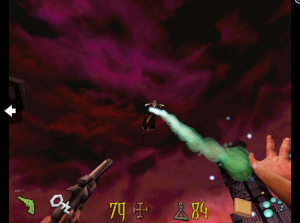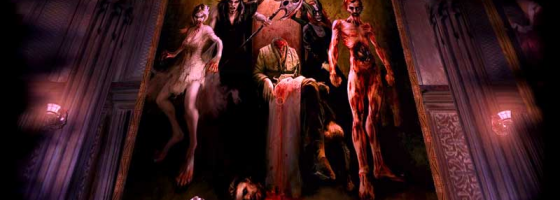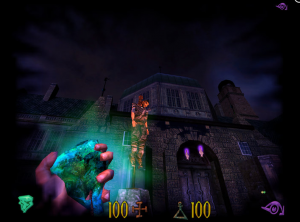Examining the praise behind both Bioshock and Bioshock Infinite, the series is one of the few FPS out there to have a developed story instead of just action. And truth be told, the list of shooters released that tell a coherent narrative beyond just shooting up enemies is small to say the least. But today’s game: Clive Barker’s Undying not only managed to beat Bioshock to the punch, but arguably had better gameplay to boot.
Clive Barker’s Undying:
Undying was a FPS horror title released in 2001 by DreamWorks Interactive. As evident by the title, Undying was a collaboration between DreamWorks, EA and horror writer Clive Barker.
You have to remember that the push for stronger narratives in the Game Industry was still in its infancy both for technology and writing in general. Clive Barker’s Undying was one of the first cases where the Game Industry went outside to seek professionals to assist with making a game.
Right off the bat Undying featured an engrossing story compared to other shooters at the time. The player is Patrick Galloway: a paranormal investigator who has been summoned by his friend and war buddy — Jeremiah Covenant.
Jeremiah is dying and is afraid of a curse that he and four siblings enacted with a ritual during their childhood, which caused each of them to go mad before death. The four siblings have been resurrected as demons that are now causing trouble and waiting for Jeremiah to die to complete the ritual. To complicate matters, Patrick’s rival is at the estate and is out to get him.
Undying was somewhat linear as the player could explore the estate looking for clues as to what happened. There weren’t any levels in the basic sense, but areas that the player had to explore for important items. As Undying was a horror game, enemies did their best to surprise the player, and getting hit would cause the screen to lurch violently.
Besides the engrossing story, Undying featured an interesting two-weapon combat system several years before Bioshock attempted it.
Patrick’s arsenal included basic guns, magical weapons and spells that were found during play. As in Bioshock, one hand used all the spells while the other was for weaponry, but the system was easier to use in Undying.

Undying’s dual weapon system gave players more freedom in combat thanks to weapon variety and a recharge-able magic resource.
During play the player could switch between weapons assigned to both hands at will and use either weapon type immediately during combat.
This by itself allowed for more varied combat compared to the original Bioshock that required players to switch between plasmid and weapon mode.
But where Undying arguably succeeded over both Bioshocks was with the constraints of the magic system. The problem that both design teams faced with their second combat system was balancing its use. If the player could just throw fireballs or lightning bolts infinitely, the game’s balance would be shot.
Bioshock went with limiting the player with the resource: eve that could only be replenished by outside means. This meant that the player could easily run out and be unable to use their plasmids during a fight. By limiting eve this way it makes the Bioshock series similar to JRPGs where the player feels like they have to hoard their items for “that big fight” instead of making use of all their options.
Undying had a limiting mechanic in the form of magic power, but they went a different way in replenishing it. The player’s magic supply started at 100 and dropped every time the player used a spell. However magic would slowly refill when the player was not using any spells. Running out of magic during a tough fight was a sign of trouble, as your magic would not recover quick enough to start blasting enemies again.
But the big difference was that by basing Undying’s magic system on a resource that could be recovered without outside aid, gave the player more freedom. The player was still limited by magic power, but there was never a case where the player had to worry about not having enough magic power for a future fight.
Undying even went as far as giving the player the option of fighting as a pure spell caster. The mcguffin in the game: a magic stone could be equipped in place of a regular weapon.
While the player was holding the stone they could only use spells to attack, but they had several additional benefits. Magic power recovered faster, spell damage was increased and the stone could be used to push back attacking enemies.
The enemy variety of Undying was pretty good, as each sibling effectively had their own army of monsters to throw at the player. While none of them could be categorized as mid bosses like the Big Daddies, they were still dangerous in their own right. Undying did feature boss fights in the form of the sibling fights which were a way of breaking out of the normal routine.
Funny enough both Undying and Bioshock do share one element in common: a final boss fight that broke the flow of the game.
It’s a tossup between Bioshock’s super saiyan 1920’s gangster or Undying’s giant squid with a dynamite allergy as to what was the worse fight.
Undying rated highly but wasn’t a huge hit. At a time where shooters were becoming more multiplayer oriented, Undying’s singleplayer only campaign wasn’t popular with the competitive crowd. There were plans to release a multiplayer mode, but the lack of sales stopped development on it.
But the big nail in the coffin came with Clive Barker’s second involvement in the game industry: Jericho. This was universally panned and all but sealed the fate of having him return for a sequel to Undying.
Undying remains as one of my favorite shooters and would have been #1 on the list if not for tomorrow’s game.
Up Next: A European Vacation




Pingback: 5 Cures to Modern FPS-- Stalker: Shadows of Chernobyl | Game Wisdom()